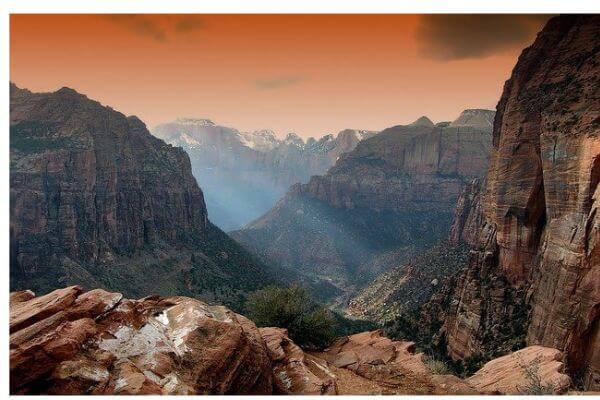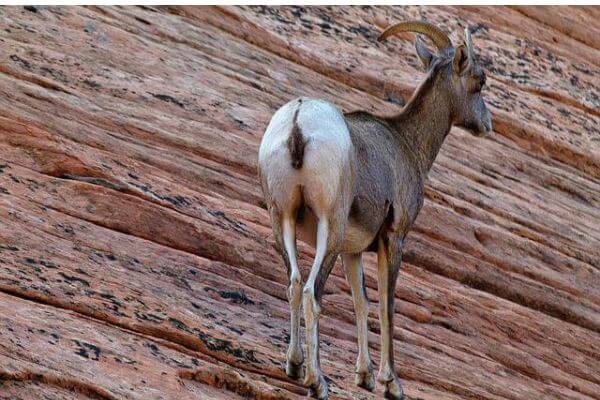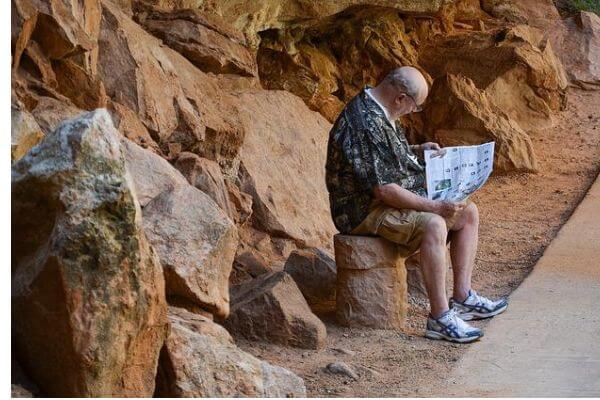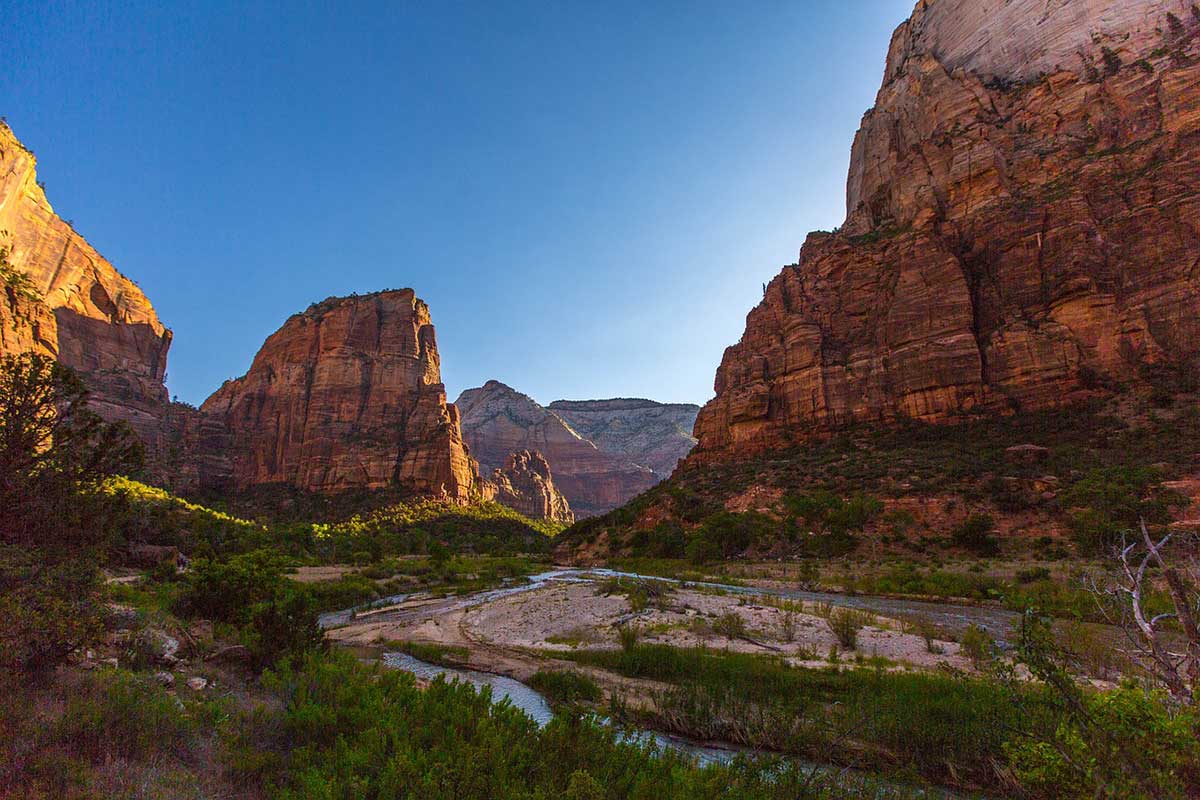Located in the southwest corner of Utah lies Zion National Park, Utah’s oldest national park. Known for its spectacular palette of colors and sweeping views, Zion is one of the largest national parks in the country in terms of visitors and hosts millions of visitors every year. The park has a rich history with many glimpses of this history remaining intact throughout the park. This moderately sized national park offers activities for all ages and abilities, ranging from driving tours to extreme wilderness backpacking.
Facts About Zion National Park
1. The Name
“Zion” Holds Religious Meaning
Isaac Behunin, the first European settler to make his home in the canyon, built a one-room cabin in 1861 and was soon joined by other settlers. Behunin proclaimed of his new home, “A man can worship God among these great cathedrals as well as in any man-made church – this is Zion.” The name has stuck over the years.
2. The Virgin River Constantly Reshapes Zion
The Virgin River cuts through Zion National Park. The river has cut away at the canyon for millions of years, creating new formations and reforming the landscape. Many of the park’s most notable and visited sites were created by the river, including The Narrows.
Over 165 miles of the river flow through federal land, including Zion and the Bureau of Land Management. Various trails in the park are centered around the river. Some of these trails are for more experienced hikers, while others are manageable for visitors of all ages and abilities.
3. Hiking is a Mainstay in the Park

Hiking is a must for visitors to national parks, and Zion is no different. Zion National Park is home to 35 hiking trails ranging in terrain. While there are short loop trails, many of the marked trails in the park are not loops. If you’re not familiar with hiking, non-loop trails are those that do not bring you back to your starting point. Day hikers use these trails and turn around at any point to return to their starting point.
Some of the difficult trails include East Rim Trail, which averages 9 hours and is 11 miles one-way. West Rim Hike averages 12 hours and is 15 miles one-way. Both require two vehicles (one at the entrance, one at the destination).
Easy hikes include Riverside Walk, averaging 1.5 hours for the 2.2-mile roundtrip. Archeology Trail is just a 30-minute hike and 0.4-miles.
If day hikes aren’t your thing and you’re looking for something a little more advanced, backpacking is available in the park with a permit.
4. Zion National Park is a Wonderland for Plant and Animal Species

The National Park System protects various sections of land and preserves them. Numerous native plant and animal species thrive in national parks, including Zion. In terms of diversity, Zion National Park is home to more species of plants than the Hawaiian Islands!
Zion has multiple microclimates, allowing for great diversity in animal life. Nearly 70 species of mammals, 291 species of birds, and almost 40 species of reptiles and amphibians call the park home. Predators in the park include mountain lions, bobcats, gray foxes, and coyotes.
5. Zion is the 36th Largest National Park in the U.S.
Zion covers just over 147,000 acres or 229 square miles. While this is a large area of land, its size is dwarfed by the largest national parks! The largest national park in the United States, Wrangell-St. Elias National Park and Preserve is 13,175,901 acres! The sizes of other well-known national parks also dwarf Zion: Yellowstone is over 2 million acres, the Everglades is over 1.5-million, and Glacier is over 1 million.
6. You Can Car Camp in Zion
Zion has three designated campgrounds for visitors with RVs or tents who want the convenience of car camping. Two of the campgrounds, Watchman and South, are in the desert part of the park. When camping in these two campgrounds, it is imperative you plan for the daytime temperatures. Each campground has comfort stations. Reservations are recommended for both as they fill up quickly.
Lava Point Campground has only six primitive sites. These sites are first-come, first-serve. Pit toilets are available, but there is no potable water. Lava Point closes from October through April (or for the winter season).
7. Backpacking Zion Takes Your Experience to Another Level

Backpacking is camping on another level. With many miles of wilderness trails, Zion is a backpacker’s dream destination. The park requires permits for backpackers, which are easily found on the National Park Service’s website.
Numerous designated sites lie within the park’s boundaries along several trails. While backpacking always carries an element of adventurous danger, Zion’s desert climate poses extremes for backpackers in the park. The National Park Service recommends mapping out water sources before you head out on your adventure. Potable water is available at several places within the park, including campgrounds, museums, and visitor’s centers. The park recommends a minimum of one gallon per hiker, per day.
Toxins are present in some of the natural water sources in the park, some of which are resistant to all known forms of filtering. Refuse water from rivers, creeks, and washes, and use natural springs only as an emergency source of water.
8. Zion has Outlying Communities to Enhance Your Visit
If you’re not staying in the park’s lodge or campgrounds, you have several outlying towns and cities to stay in. Depending on your interests, you can attend various annual events, explore various restaurants, and add to your adventure with activities like helicopter rides.
Springdale may be the most visited outlying community neighboring Zion. With art galleries, restaurants, and lodging choices for every budget, Springdale is a welcome respite from a long journey of sightseeing and hiking. Other towns within a 45-minute drive include Washington, St. George, and Ivins.
